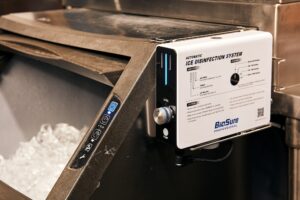You may have had the experience of feeling sick after having unhygienic food? Foodborne illnesses have been a critical topic on public health, and contribute significantly to the cost of health care around the world. The CDC estimates that each year foodborne illnesses sicken 48 million Americans (approximately 17 percent of people in the United States) and lead to 128,000 hospitalizations and 3,000 deaths.
In order to improve to reduce a business’ risk of serving unsanitary food to their customers, and to ease the burden on public healthcare, it’s crucial to know best practices and establish standard routines in the preparation, handling, and storage of food to prevent foodborne illness. Although more is known today than ever before about the risks of contamination in the food chain, from production to plating, businesses still face challenges in maintaining food safety.
The Challenges of Chlorine
Chlorine has traditionally been one of the most commonly used disinfectants for water and equipment disinfection. Although not without its disadvantages, It is very effective for the deactivation of pathogenic microorganisms.
However, chlorination has major drawbacks. For restaurants, hospitality, and catering industries, for example, the use of chlorine-based sanitizing systems requires frequent deliveries, expensive hot water, dedicated storage space, and the training and tasking of employees on how to measure and mix proper proportions of chemical cleaning agents.
That means extra costs and efforts for businesses. Also, chlorination has a potential taste and odor objections, meaning chlorine-based systems require substantial rinsing. Inadequate rinsing can result in the addition of an unacceptable bleach flavor to food products.
A Better Alternative?
Ozone water or ozonated water treatment is considered a safe and effective disinfectant for food applications. Including decontamination of water and sterilization of kitchen equipment, ozonated water can directly oxidize and decompose the cell membrane of bacteria, causing osmotic bursting meaning bacteria cannot survive in ozone water.
Ozone (O3) is an unstable gas comprising three atoms of oxygen. It is unstable because the gas will readily degrade back to its stable state, diatomic oxygen (O2) with the formation of free oxygen atoms or free radicals. The free oxygen atoms or radicals are highly reactive and they will oxidize almost anything (including viruses, bacteria, organic and inorganic compounds) in contact, making ozone an enormously powerful disinfectant and oxidizer.
In fact, ozone is a much stronger oxidizer than other common disinfectants such as chlorine and hypochlorite. The usage of chlorine or hypochlorite in many countries has been decreased significantly due to the possibility of the formation of carcinogenic by-products such as trihalomethanes (THM) during the disinfection process.
In contrast, ozone disinfection does not produce any harmful residues, and all the residual ozone will be converted back to oxygen within a short time. Ozone is therefore considered as an environmentally friendly disinfectant.
Compared with general chlorine disinfectants, the sterilization speed of ozone water (also known as ozonated water) is 3,000 times faster, and its sterilization ability is 50 times stronger. Aqueous ozone is effective against E. coli populations whether they are found on the surface of foodstuffs, or on the hands of food handlers, who can immerse their hands in ozonated water rinses during food preparation. Ozonated water prevents decay and thus extends shelf life by eliminating decomposition agents such as bacteria, yeast, and molds, and enhances food safety by reducing populations of foodborne pathogens, including E. coli, Salmonella, Listeria, and Shigella.
From a business operation perspective, ozone water is the safest and most effective method for sanitization. Ozonated water is a cold-water disinfection agent. Compared to chlorine, there is no hot water or storage of chemicals needed with ozonated water. Training food handlers to use ozonated water is very simple: Just immerse the food in ozonated water for at least 30 seconds. Moreover, ozone water is environmentally safe as the ozone molecules naturally revert to oxygen within 20 minutes. Therefore, dedicated disposal procedures are not required, like chlorine-based products; and no harmful residues would be left behind.
Because of its safe and reliable characteristics, ozone has been approved as disinfection and sanitizing agent for more than 16 years when the FDA granted GRAS status approval in 2001. Ozone is also approved by FDA as a food additive.
Applications of Ozonated Water
Ozonated water in the wash environment can enhance food safety by killing waterborne and surface pathogens on food products, processing equipment, and contact points of food handlers. Unlike chlorine sterilization processes, it leaves no chemical residual, no taste or smell after reaction, and with BES systems, there will be no effect on the pH balance of water, which makes it the perfect disinfection for hotels, restaurants, and catering businesses.
Today, new advanced ozonated water systems have been designed to integrate into existing food production, processing, and handling facilities. For example, the Central Ozone Water Sanitization System by BioSure uses water electrolysis technology to generate ozone-dissolved water containing high purity ozone that can be used for handwashing before cooking, food ingredients washing, food processing station cleaning, and tool disinfection. The system can be integrated with the existing water supply, transforming the general tap water into high-concentration antibacterial disinfection water.
Many familiar brand names, such as WM Morrison Supermarkets, Loblaw supermarket, Shangri-La Hotels and Resorts, Maxim’s Inn, and Worldwide Seafood Ltd, are successfully utilizing BioSure Ozone Water Sterilization System to accomplish high levels of food safety. “Food safety is the first priority of our company.” a representative from Worldwide Seafood said, “We use BioSure’s products to eliminate all potential risks to our customers and to ensure that the processing process meets the world Hazard Analysis Critical Control Point (HACCP) standards.”
“We use BioSure’s products to avoid possible cross-contamination of food products at any time during our work.” says a representative from WM Morrison Supermarkets.“Whether in employee hand washing or surface disinfection of equipment, we rely on BioSure to help us maintain quality and food safety. During our long-term cooperation, BioSure products have proved their value and have been fully trusted by us.”
Since 1988, BES Group has been a leading electrolytic ozone manufacturer dedicated to “chemical-free” sanitation solutions. BioSure Professional, under BES Group, provides professional solutions applying advanced ozone technologies in food safety and hygiene, commercial laundry, air quality control, water treatment, healthcare, and other industries. Our sanitation solutions have helped numerous global corporations and organizations, spanning hospitality to medical care industries, to reduce millions of chemical detergents used annually. To see more details of our various solutions, please visit our official website: www.biosureozne.com
Copyright besgroups.com All Rights Reserved
Related Articles
Preventing Foodborne Illnesses with Ozone Sanitation for the Kitchen
Ozone Solution Simplifies Food Preparation Safety for Major Five Star Hotel Chains
Food Safety and Ozone: How Ozone is Becoming the Industry Standard



